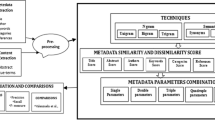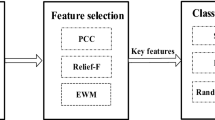Abstract
We argue that citations in scholarly documents do not always perform equivalent functions or possess equal importance. To address this problem, we worked with a corpus of over 21 k citations from the Association for Computational Linguistics, from which 465 citations were randomly annotated by experts as either important or unimportant. We used an array of machine-learning models on these annotated citations: Random Forest (RF); Support Vector Machine (SVM); and Decision Tree (DT). For the classification task, the selected models employed 15 novel features: contextual; quantitative; and qualitative. We show that the RF model outperformed the comparative model by 9.52%, achieving a 92% precision-recall area under the curve. We present a prototype of a scientific publication search system based on the RF prediction model for feature engineering. This was used on a dataset of 4138 full-text articles indexed by PLOS ONE that consists of 31,839 unique references. The empirical evaluation shows that the proposed search system improves visibility of a given scientific document by including, along with its index terms, terms from the works that it cites that are predicted to be important. Overall, this yields improved search results against the queries by the user.






Similar content being viewed by others
References
Ananiadou, S., Thompson, P., & Nawaz, R. (2013). Enhancing search: Events and their discourse context. International conference on intelligent text processing and computational linguistics. (pp. 318–334). Springer.
Athar, A. (2011). Sentiment analysis of citations using sentence structure-based features. In Proceedings of the ACL 2011 student session (pp. 81–87). Association for Computational Linguistics.
Batista-Navarro, R. T., Kontonatsios, G., Mihăilă, C., Thompson, P., Rak, R., Nawaz, R., Korkontzelos, I., & Ananiadou, S. (2013). Facilitating the analysis of discourse phenomena in an interoperable NLP platform. In International conference on intelligent text processing and computational linguistics (pp. 559–571). Springer.
Bhagavatula, C., Feldman, S., Power, R., & Ammar, W. (2018). Content-based citation recommendation. In Proceedings of the 2018 conference of the North American chapter of the association for computational linguistics: Human language technologies, Volume 1 (Long Papers) (pp. -251).
Bonzi, S. (1982). Characteristics of a literature as predictors of relatedness between cited and citing works. Journal of the American Society for Information Science, 33(4), 208–216.
Bornmann, L., Haunschild, R., & Hug, S. E. (2018). Visualizing the context of citations referencing papers published by Eugene Garfield: A new type of keyword co-occurrence analysis. Scientometrics, 114(2), 427–437.
Bornmann, L., Wray, K. B., & Haunschild, R. (2020). Citation Concept Analysis (CCA): A new form of citation analysis revealing the usefulness of concepts for other researchers, illustrated by exemplary case studies including classic books by Thomas S Kuhn and Karl R. Popper. Scientometrics, 122(2), 1051–1074.
Boyack, K. W., van Eck, N. J., Colavizza, G., & Waltman, L. (2018). Characterizing in-text citations in scientific articles: A large-scale analysis. Journal of Informetrics, 12(1), 59–73.
Cano, V. (1989). Citation behavior: Classification, utility, and location. Journal of the American Society for Information Science, 40(4), 284–290.
Cohan, A., & Goharian, N. (2018). Scientific document summarization via citation contextualization and scientific discourse. International Journal on Digital Libraries, 19(2–3), 287–303.
Conrad, J. G., & Dabney, D. P. (2001). Automatic recognition of distinguishing negative indirect history language in judicial opinions. In Proceedings of the 10th international conference on information and knowledge management (pp. 287–294). ACM.
Councill, I. G., Giles, C. L., & Kan, M.-Y. (2008). ParsCit: An open-source CRF reference string parsing package. In LREC (Vol. 8, pp. 661–667).
Ding, Y., Zhang, G., Chambers, T., Song, M., Wang, X., & Zhai, C. (2014). Content-based citation analysis: The next generation of citation analysis. Journal of the Association for Information Science and Technology, 65(9), 1820–1833.
Dong, Y., Ma, H., Shen, Z., & Wang, K. (2017). A century of science: Globalization of scientific collaborations, citations, and innovations. In Proceedings of the 23rd ACM SIGKDD international conference on knowledge discovery and data mining (pp. 1437–1446). ACM.
Drongstrup, D., Malik, S., Aljohani, N. R., Alelyani, S., Safder, I., & Hassan, S. U. (2020). Can social media usage of scientific literature predict journal indices of AJG, SNIP and JCR? An altmetric study of economics. Scientometrics, 125(2), 1541–1558.
Finney, B. (1979). The reference characteristics of scientific texts. Ph.D. thesis, City University, London.
Garfield, E. (1965). Can citation indexing be automated. In Statistical association methods for mechanized documentation, symposium proceedings (Vol. 269, pp. 189–192). National Bureau of Standards, Miscellaneous Publication 269, Washington, DC.
Garzone, M., & Mercer, R. E. (2000). Towards an automated citation classifier. In Conference of the Canadian Society for computational studies of intelligence (pp. 337–346). Springer.
Hassan, S.-U., Akram, A., & Haddawy, P. (2017a). Identifying important citations using contextual information from full text. In Proceedings of the 17th ACM/IEEE joint conference on digital libraries (pp. 41–48). IEEE Press.
Hassan, S. U., Imran, M., Iftikhar, T., Safder, I., & Shabbir, M. (2017b). Deep stylometry and lexical & syntactic features based author attribution on PLoS digital repository. In International conference on Asian digital libraries (pp. 119–127). Springer.
Hassan, S. U., & Haddawy, P. (2013). Measuring international knowledge flows and scholarly impact of scientific research. Scientometrics, 94(1), 163–179.
Hassan, S. U., & Haddawy, P. (2015). Analyzing knowledge flows of scientific literature through semantic links: A case study in the field of energy. Scientometrics, 103(1), 33–46.
Hassan, S. U., Imran, M., Iqbal, S., Aljohani, N. R., & Nawaz, R. (2018a). Deep context of citations using machine-learning models in scholarly full-text articles. Scientometrics, 117(3), 1645–1662.
Hassan, S.-U., Iqbal, S., Imran, M., Aljohani, N. R., & Nawaz, R. (2018b). Mining the context of citations in scientific publications. In International conference on Asian Digital Libraries (pp. 316–322). Springer.
Hassan, S.-U., Safder, I., Akram, A., & Kamiran, F. (2018c). A novel machine-learning approach to measuring scientific knowledge flows using citation context analysis. Scientometrics, 116(2), 973–996.
Hoffmann, A., & Pham, S. B. (2003). Towards topic-based summarization for interactive document viewing. In Proceedings of the 2nd international conference on knowledge capture (pp. 28–35). ACM.
Hooten, P. A. (1991). Frequency and functional use of cited documents in information science. Journal of the American Society for Information Science, 42(6), 397–404.
Hu, Z., Chen, C., & Liu, Z. (2013). Where are citations located in the body of scientific articles? A study of the distributions of citation locations. Journal of Informetrics, 7(4), 887–896.
Jahangir, M., Afzal, H., Ahmed, M., Khurshid, K., & Nawaz, R. (2017) An expert system for diabetes prediction using auto tuned multi-layer perceptron. In 2017 Intelligent systems conference (IntelliSys) (pp. 722–728). IEEE.
Karimi, S., Moraes, L., Das, A., Shakery, A., & Verma, R. (2018). Citance-based retrieval and summarization using IR and machine learning. Scientometrics, 116(2), 1331–1366.
Kumar, S. (2016). Structure and dynamics of signed citation networks. In Proceedings of the 25th international conference companion on world wide web (pp. 63–64). International World Wide Web Conferences Steering Committee.
Lamers, W., van Eck, N. J., Waltman, L., & Hoos, H. (2018). Patterns in citation context: The case of the field of scientometrics. In 23rd International conference on science and technology indicators (STI 2018), September, Leiden, The Netherlands. Centre for Science and Technology Studies (CWTS).
Ma, S., Xu, J., & Zhang, C. (2018). Automatic identification of cited text spans: A multi-classifier approach over imbalanced dataset. Scientometrics, 116, 1303–1330.
Ma, S., Zhang, C., & Liu, X. (2020). A review of citation recommendation: From textual content to enriched context. Scientometrics, 122, 1445–1472.
Mayr, P., Frommholz, I., Cabanac, G., Chandrasekaran, M. K., Jaidka, K., Kan, M.-Y., & Wolfram, D. (2018). Introduction to the special issue on bibliometric-enhanced information retrieval and natural language processing for digital libraries (BIRNDL). International Journal on Digital Libraries, 19(2–3), 107–111.
Moravcsik, M. J., & Murugesan, P. (1975). Some results on the function and quality of citations. Social Studies of Science, 5(1), 86–92.
Nazir, S., Asif, M., Ahmad, S., Bukhari, F., Afzal, M. T., & Aljuaid, H. (2020). Important citation identification by exploiting content and section-wise in-text citation count. PLoS ONE, 15(3), e0228885.
Nakov, P. I., Schwartz, A. S., & Hearst, M. (2004). Citances: Citation sentences for semantic analysis of bioscience text. Proceed, 4, 81–88.
Nawaz, R., Thompson, P., & Ananiadou, S. (2012). Identification of manner in bio-events. In LREC (pp. 3505–3510).
Nawaz, R., Thompson, P., & Ananiadou, S. (2013). Negated bio-events: analysis and identification. BMC Bioinformatics, 14(1), 14.
Nanba, H., & Okumura, M. (1999). Towards multi-paper summarization using reference information. In IJCAI (Vol. 99, pp. 926–931).
Oppenheim, C., & Renn, S. P. (1978). Highly cited old papers and the reasons why they continue to be cited. Journal of the American Society for Information Science, 29(5), 225–231.
Pang, B., & Lee, L. (2008). Opinion mining and sentiment analysis. Foundations and Trends® in Information Retrieval, 2(1–2), 1–135.
Qayyum, F., & Afzal, M. T. (2019). Identification of important citations by exploiting research articles’ metadata and cue-terms from content. Scientometrics, 118(1), 21–43.
Qazvinian, V., Radev, D. R., Mohammad, S. M., Dorr, B., Zajic, D., Whidby, M., & Moon, T. (2013). Generating extractive summaries of scientific paradigms. Journal of Artificial Intelligence Research, 46, 165–201.
Rose, S., Engel, D., Cramer, N., & Cowley, W. (2010). Automatic keyword extraction from individual documents. In M. W. Berry and J, Kogan (Eds.), Text mining: Applications and theory, pp. 1–20. Wiley.
Safder, I., Hassan, S. U., Visvizi, A., Noraset, T., Nawaz, R., & Tuarob, S. (2020). Deep learning-based extraction of algorithmic metadata in full-text scholarly documents. Information Processing & Management, 57(6), 102269.
Safder, I., & Hassan, S.-U. (2019). Bibliometric-enhanced information retrieval: A novel deep feature engineering approach for algorithm searching from full-text publications. Scientometrics, 119, 257–277.
Safder, I., & Hassan, S. U. (2018). DS4A: Deep search system for algorithms from full-text scholarly big data. In 2018 IEEE international conference on data mining workshops (ICDMW) (pp. 1308–1315). IEEE.
Shardlow, M., Batista-Navarro, R., Thompson, P., Nawaz, R., McNaught, J., & Ananiadou, S. (2018). Identification of research hypotheses and new knowledge from scientific literature. BMC Medical Informatics and Decision Making, 18(1), 46.
Small, H. (2018). Characterizing highly cited method and non-method papers using citation contexts: The role of uncertainty. Journal of Informetrics, 12(2), 461–480.
Sugiyama, K., Kumar, T., Kan, M.-Y., & Tripathi, R. C. (2010). Identifying citing sentences in research papers using supervised learning. In information retrieval & knowledge management (CAMP), 2010 international conference (pp. 67–72). IEEE.
Tahamtan, I., & Bornmann, L. (2018). Core elements in the process of citing publications: Conceptual overview of the literature. Journal of Informetrics, 12(1), 203–216.
Thompson, P., Nawaz, R., McNaught, J., & Ananiadou, S. (2017). Enriching news events with meta-knowledge information. Language Resources and Evaluation, 51(2), 409–438.
Valenzuela, M., Ha, V., & Etzioni, O. (2015). Identifying meaningful citations. In 29th AAAI workshop: Scholarly big data. https://www.aaai.org/ocs/index.php/WS/AAAIW15/paper/viewPaper/10185/.
Voos, H., & Dagaev, K. S. (1976). Are all citations equal? Or, Did we op. cit. your idem? Journal of Academic Librarianship, 1(6), 19–21.
Wang, X., Rak, R., Restificar, A., Nobata, C., Rupp, C. J., Batista-Navarro, R. T. B., Nawaz, R., & Ananiadou, S. (2011). Detecting experimental techniques and selecting relevant documents for protein-protein interactions from biomedical literature. BMC Bioinformatics, 12(8), S11.
Zhao, D., & Strotmann, A. (2020). Deep and narrow impact: Introducing location filtered citation counting. Scientometrics, 122(1), 503–517.
Zhu, X., Turney, P., Lemire, D., & Vellino, A. (2015). Measuring academic influence: Not all citations are equal. Journal of the Association for Information Science and Technology, 66(2), 408–427.
Acknowledgements
This project was funded by the Deanship of Scientific Research (DSR), King Abdulaziz University, Jeddah, under grant No. RG-14-611-40. The authors, therefore, gratefully acknowledge DSR technical and financial support.
Author information
Authors and Affiliations
Corresponding author
Rights and permissions
About this article
Cite this article
Aljohani, N.R., Fayoumi, A. & Hassan, SU. An in-text citation classification predictive model for a scholarly search system. Scientometrics 126, 5509–5529 (2021). https://doi.org/10.1007/s11192-021-03986-z
Received:
Accepted:
Published:
Issue Date:
DOI: https://doi.org/10.1007/s11192-021-03986-z




